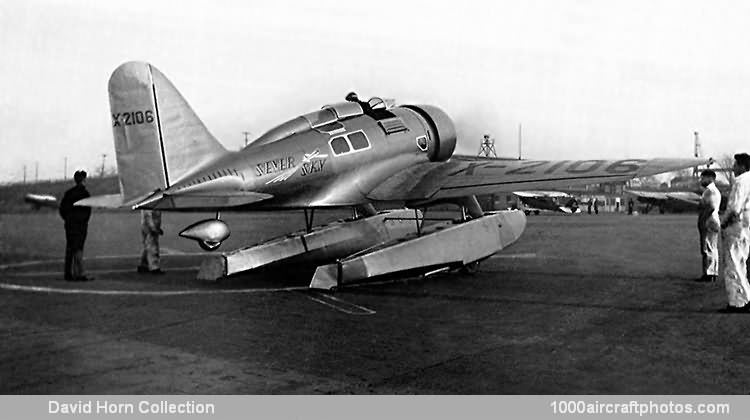10/31/2011. Remarks by Johan Visschedijk: "Both Alexander P. de Seversky and Alexander Kartveli of the Seversky Aircraft Corporation were convinced that streamlined, all-metal aircraft were the key to aviation's advancement, and together they designed and produced the company's first aircraft, the SEV-3 (three-seat) - which became the one and only demonstrator to interest potential investors in the company. Having no factory of his own to produce the machine, Seversky contracted the EDO Aircraft Company of College Point, Long Island, New York, to build the aircraft.
The SEV-3 (registered NX2106) was a novel, beautifully streamlined amphibian which first flew in April 1933. It was a bronze-colored three-seat all-metal low-wing monoplane with a new and unusual landing gear consisting of two single-step pontoon floats and two wheels. The wheels retracted into recessed slots in the floats, were supported directly from the wings (not the floats) and were extended from the floats by hydraulic power. When the aircraft was operating from the water, the wheels were retracted into the floats; when operating from land, the wheels were extended and the floats were free to pivot upwards, allowing small auxiliary wheels at the rear of the floats, and the tail wheel, to be in contact with the ground.
The SEV-3 also featured all the latest innovations in design and construction which Seversky had developed. These included its all-metal, stressed-skin monocoque fuselage and cantilever wing which gave an unusually good weight-to-strength ratio. The one-piece wing was also designed in such a way that its actual structure was used as the container for the fuel (i.e. it was a 'wet wing'), thus eliminating the necessity of inserting wing tanks. The aircraft was powered by an air-cooled Wright R-975 of 420 hp, enclosed in a NACA cowling. The SEV-3 had a length of 25 ft 8 in (7.82 m) and a wing span of 36 ft (10.97 m).
The chief object of most of Seversky's research and development was, however, a long-range pursuit aircraft, of which the SEV-3 was the forerunner. Nonetheless Seversky set several speed records and gathered considerable attention with his SEV-3. On October 9, 1933 he flew the aircraft at 180 mph (290 kmh) at New York's Roosevelt Field, thus setting a new speed record for amphibians. Subsequently the floats were removed and a 'trouser' landing gear was fitted, in this form it had the makings of Seversky's first fighter.
The aircraft was modified back to an amphibian and fitted with a Wright SR-1820 Cyclone engine of 710 hp; it was redesignated SEV-3M. On September 15, 1935, Seversky reached 230 mph (370 kmh), setting yet another world speed record for amphibians and proving that the SEV-3 was comparable to the best landplanes of the period. This record was among the first of what would become a long series captured by Seversky/Republic aircraft.
Because of the previous success of this aircraft, Seversky received an order in August 1935 for three of a similar machine, the SEV-3M-WW, from Colombia, which, with its extensive network of rivers, had a need for amphibious aircraft. This was the first of several foreign sales. At the time Seversky still did not possess his own factory, so the Kirkham Engineering Company of Farmingdale, Long Island, was contracted to build the aircraft.
However, before Kirkham had managed to complete one aircraft, and with the other two only at the component stage, all the advance funding was expended and work was stopped. Seversky then took over an empty factory building on the same airfield in Farmingdale and continued the construction of the three aircraft. This move marked the establishment of the Seversky/Republic aircraft factory at Farmingdale, where the company was to remain until its final days in 1987.
Seversky completed the three aircraft as ordered and they were then accepted by the Colombian Government with the balance of the contract paid. Fitted with armament and radio equipment, the three SEV-3M-WWs were used for reconnaissance duties. They had a top speed of 200 mph (322 kmh) and a ceiling of 22,000 ft (6,706 m).
Needing money, in December 1936 Seversky sold the original SEV-3M to Robert Fierro, a Mexican AF colonel, who in turn sold it to Gordon Ordaz, the Spanish Ambassador to Mexico. In December 1937 the SEV-3M was shipped to Spain, along with several assorted US aircraft, and it was ultimately destroyed during the Spanish Civil War."
